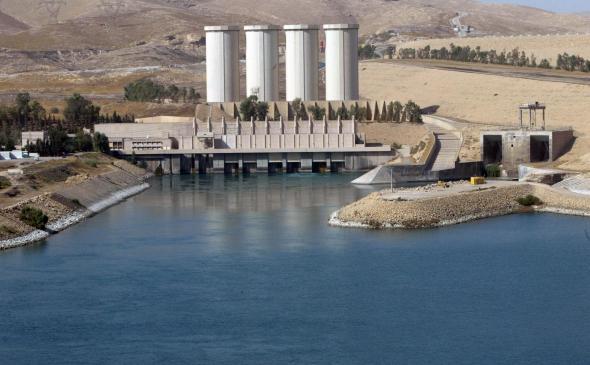Update, Aug. 7, 2014, 11:30 a.m.: According a number of accounts based on local sources, ISIS militants now appear to be in control of the Mosul Dam, Iraq’s largest. This post from Aug. 5 looked at the history of dams as weapons of war.
There are still conflicting reports about who’s in control of the Mosul Dam, Iraq’s largest hydroelectric facility. Kurdish officials report that Peshmerga forces held back an advance by ISIS fighters, who had reached a housing facility for workers near the dam over the weekend. Even so, the prospect of the dam falling into ISIS’ hands is alarming. A 2007 U.S. report warned that a failure at the facility—which the U.S. spent more than $27 million to refurbish—“could send a 20-meter, or 65-foot, flood wave through Mosul.”* While it’s unlikely that ISIS would want to flood a city it currently controls, it’s not an option that Kurdish or Iraqi forces would want to leave open going forward.
As Slate’s Eric Holthaus noted recently, unusually dry conditions in the region have made the control of water resources especially critical in Syria and Iraq. But there’s also a long history of dams being used as weapons of war, including in this region.
As Paul Mutter recounts in an essay for Medium’s “War Is Boring” collection, “Cyrus the Great reputedly took Babylon in a single night in the 6th century, B.C., by diverting an old artificial lake back into the Euphrates, so that his army could come right up to the city walls at night.” The most famous instance of dam warfare in history is probably the Royal Air Force’s “dambusters” raid on Germany’s industrial heartland in 1943, which destroyed the Möhne and Eder reservoirs, flooding 50 miles of the Ruhr valley and killing almost 1,300 people. While the operation was a major morale booster for the British public—and was dramatized in a popular film during the 1950s—its impact on German industrial production was minimal.
But this pales in comparison with what’s been called the “largest act of environmental warfare in history”: the Nationalist Chinese Army’s 1938 diversion of the Yellow River. In an effort to block Japanese troops before they reached the strategically important city of Wuhan, nationalist leader Chiang Kai-shek ordered his forces to blow up a key dike on the Yellow River, knowing full well that it would flood a huge portion of central China. (Chinese generals had been using similar strategies since the 12th century.)
According to official Chinese estimates, more than 800,000 Chinese civilians were killed in the resulting flooding and millions more were forced to flee. The Japanese suffered only minor casualties and took Wuhan three months later.
With more than 20,000 large dams in China, security at these facilities remains a major concern for the Chinese in particular. Globally, experts have also warned that dams could be targeted by cyber-attacks. Though dambusting may not be a new military idea, as the fighting in Mosul shows, it’s still a major threat.
*Correction, Aug. 5, 2014: This post originally misstated that the U.S. spent $27 billion on reinforcing the Mosul Dam. The cost was $27 million.
